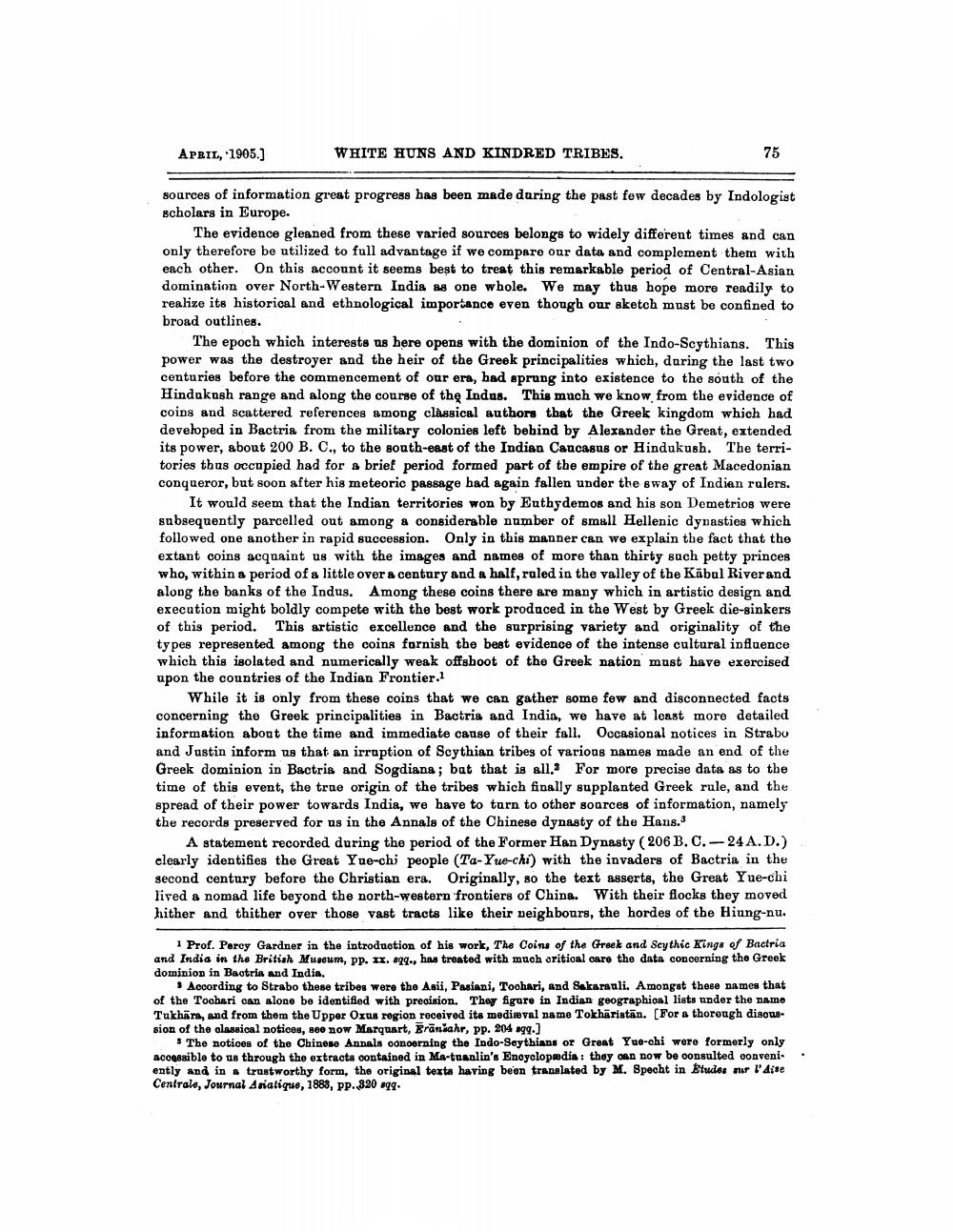________________
APRIL, "1905.)
WHITE HUNS AND KINDRED TRIBES.
75
sources of information great progress has been made during the past few decades by Indologist scholars in Europe.
The evidence gleaned from these varied sources belongs to widely different times and can only therefore be utilized to full advantage if we compare our data and complement them with each other. On this account it seems best to treat this remarkable period of Central-Asian domination over North-Western India as one whole. We may thus hope more readily to realize its historical and ethnological importance even though our sketch must be confined to broad outlines.
The epoch which interests us here opens with the dominion of the Indo-Scythians. This power was the destroyer and the heir of the Greek principalities which, during the last two centuries before the commencement of our era, had sprung into existence to the south of the Hindukush range and along the course of the Indus. This much we know from the evidence of coins and scattered references among clàssical authors that the Greek kingdom which had developed in Bactria from the military colonies left behind by Alexander the Great, extended its power, about 200 B. C., to the south-east of the Indian Caucasus or Hindukush. The territories thas occupied had for a brief period formed part of the empire of the great Macedonian conqueror, but soon after his meteoric passage bad again fallen under the sway of Indian rulers.
It would seem that the Indian territories won by Euthydemos and his son Demetrios were subsequently parcelled out among a considerable number of small Hellenic dynasties which followed one another in rapid succession. Only in this manner can we explain the fact that the extant coins acquaint us with the images and names of more than thirty such petty princes who, within a period of a little over a century and a half, ruled in the valley of the Kābul Riverand along the banks of the Indus. Among these coins there are many which in artistic design and execution might boldly compete with the best work produced in the West by Greek die-sinkers of this period. This artistic excellence and the surprising variety and originality of the types represented among the coins fornish the best evidence of the intense cultural influence which this isolated and numerically weak offshoot of the Greek nation must have exercised upon the countries of the Indian Frontier.1
While it is only from these coins that we can gather some few and disconnected facts concerning the Greek principalities in Bactria and India, we have at least more detailed information about the time and immediate cause of their fall. Occasional notices in Strabo and Justin inform us that an irraption of Scythian tribes of various names made an end of the Greek dominion in Bactria and Sogdiana; bat that is all. For more precise data as to the time of this event, the true origin of the tribes which finally supplanted Greek rule, and the spread of their power towards India, we have to turn to other sources of information, namely the records preserved for us in the Annals of the Chinese dynasty of the Hans.
A statement recorded during the period of the Former Han Dynasty ( 206 B.C. - 24 A.D.) clearly identifies the Great Yue-chi people (Ta-Yue-chi) with the invaders of Bactria in the second century before the Christian era. Originally, so the text asserts, the Great Yue-chi lived a nomad life beyond the north-western frontiers of China. With their flocks they moved hither and thither over those vast tracts like their neighbours, the hordes of the Hiung-nu.
1 Prof. Perey Gardner in the introduction of his work, The Coins of the Greek and Scythic Kings of Bactria and India in the British Museum, pp. XX. 899., has treated with much oritical care the data concerning the Greek dominion in Bactria and India.
According to Strabo these tribes were the Asii, Pasiani, Toohari, and Sakarauli. Amongst these names that of the Toohari can alone be identified with precision. They figure in Indian geographical lists under the name Tukhara, and from them the Upper Oxos region received its medieval namo Tokharistān. [For a thorough discussion of the classical notices, see now Marquart, Erāniahr, pp. 204 399.]
The notices of the Chinese Annals ooncerning the Indo-Soythians or Great Yue-chi were formerly only Acoqasible to us through the extracts contained in Ma-tuanlin's Enoyolopaedia : they on now be consulted conveni ently and in a trustworthy form, the original texts having been translated by M. Specht in Etudes sur l'Aise Centrale, Journal Asiatique, 1883, pp. 820 899.




